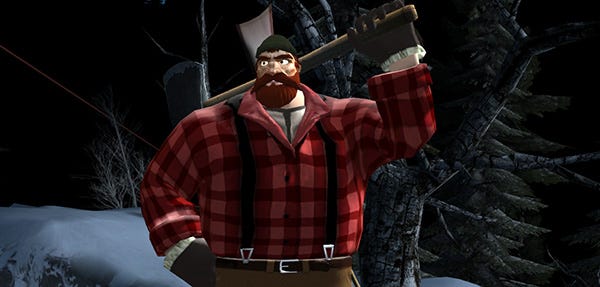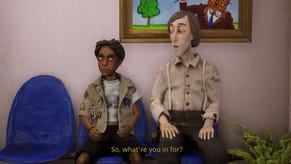Wot I Think: Sang-Froid - Tales of Werewolves
Wolves Must Die
Artifice Studio's newly-released Sang-Froid: Tales of Werewolves is, for lack of a better term, an action-strategy-roleplaying game about trying to defend a small community in the 19th century Canadian wilderness from invading wolf-creatures. It's both fascinating and infuriating: here's why.
Sang-Froid might have had a bit of a rummage around in tower defence's wardrobe, but it comes out of it wearing an outfit so different that you mightn't ever guess its origins. Specifically, it's akin to that breed of boots-on-the-ground tower defence/action-RPG crossover, as seen in the likes of Orcs Must Die and Sanctum, but with a survivalist bent. You play as one of two bearded, bickering brothers (the burly one means Normal difficulty, the skinny one means Hard) who barely have anything other than sticks, stones, rope and their inadvertently fashionable checked shirts to defend their family and friends from a seemingly endless invasion of supernatural horrors.
Making it through a level feels desperate and stressful rather than indulgently genocidal. You've only a handful of traps, all of which are used up if activated just once. Your rifle takes up to ten terrifying seconds to reload. Most of the enemies you face will be almost completely resistant to whatever weapons you've decided to take with you. The holdings you need to defend are scattered across huge areas, which you either need to slowly sprint between or spend precious money on ziplines to reach them at speed. Every trap, platform or bonfire you place, in fact, eats away at the vanishingly small amount of money you have to spend on better gear for yourself - manage to scrape together $10 in Sang-Froid and you're like a king.
No matter how well you might do in the face of all this adversity, all you can ultimately achieve is to grimly hold out until dawn, when the monsters retreat to prepare for the next night's onslaught. While they do that, you buy weapon upgrades, set up new traps and, if you've levelled up, agonise between whether to spend your skill points on upgrades to melee, the achingly slow-to-load rifle or the many different sorts of traps. The choice is rarely an easy or obvious one.
My teeth hurt from gritting them. My brow aches from furrowing it. At least my legs don't feel as stiff as they usually do when I spend a while with a videogame, as I find I need to go for walk and calm down after each level. It's not that it's especially difficult, really - it's relentless. It's relentless even though it throws relatively small numbers of enemies at you, because it spreads them far and wide so you, with your limited stamina, need to exhaustedly sprint all over the place, and because almost none of them can be killed quickly and/or easily.
While you can make it a certain way by simply attacking whichever wolves, werewolves, ancient-spirits-in-wolf-form and will o'the wisps you can reach or lure to you before they trash one of the wooden buildings under you care, surviving does require mastering some fairly complex and risky strategies, devised within a top-down map before each mission begins, and enacted from a third person perspective once it has. For instance, arguably the most powerful trap is the rope net, which hangs above what is hopefully a wolftastic thoroughfare but can only be activated by you firing a shot at it. So you lurk near it, trying to time it just right so it snares a maximum number of beasts. Shoot too early and you might only catch one or two; shoot too late and they might have all charged past it and are now cheerfully converging on your face.
Plus the sound of the shot will likely attract other wolves within earshot, so it's good odds that you'll be overwhelmed. You're reasonably handy against one or two foes, but a stand-up fight against four or more won't go well for you. (Even if you do survive, there's the terrible knowledge that you'll need to immediately high-tail it over to the other side of the map and do it all over again before you can rest.)
On the other hand, forcing enemies to come after you is critical to luring them away from the buildings, as if any of those are trashed the level's failed. There are abilities specifically geared to getting the pack's attention, one of which involves Native American magic that can alter the direction of the wind in hope that the hairy blighters will catch the presumably piquant scent of your sweaty lumberjack shirt. If that stuff pays off, you might then need to kite a deadly horde of wolkin around the map to try and run them over a spike-trap or, if they're one of the more demonic sorts, into the temporary radius of a shrine which emits holy energy. Yeah, Sang-Froid's a pretty random grab-bag of North American mysticism, but then again it's a game about beardy 19th century Canadian blokes killing werewolves so I'm happy to take whatever it offers in my stride.
The aforementioned setting is an appealing one, offering a pre-technology aesthetic's that broadly snow, fire and facial hair, which is accompanied by a rather good, folksy soundtrack. The plot juggles all manner of horror mythology, with the likes Faust, Dracula, the Wolfman all contributing to what would be a lot of fun if it wasn't so appallingly acted. Sadly there's no option to turn off voices and stick to subtitles, or I'd have been all over it. As it was, I found myself just skipping cutscenes wholesale before too long, partly because they were painful to listen to and partly because failing a level is a regular occurrence, and replaying it means replaying the videos too. The latter's especially grating because the an ongoing tutorial runs through the bulk of the game, as it drip-feeds new trap types, and the game doesn't remember that you've already heard its lessons at least once already.
In fact, the tutorial element is the game's major stumble. It spends far too long introducing itself, leaving little time to feel unfettered and ready to experiment. Balance seemed to spike wildly too: some levels were a walkover, others had me groaning in frustration as I failed for a fourth time. It can be a bit of an endurance test, though the urge to see what it would throw at me next and to scrape together enough in-game currency to afford the small number of essential gear upgrades kept me going. Essentially, it's a tight concept in an appealing setting, but covered in so many rough edges that slogging your way through to the good stuff at its heart can feel fatiguing. It also very much looks like it was made on a limited budget - which is fine, but coupled with the voice acting issue the sense of cheapness does get distracting.
I was impressed by Sang-Froid more than I actually liked it, basically. I'm very glad to have played it though, and particularly impressed to see a refreshing, almost deconstructionist take on ground that, between Orcs Must Die, Sanctum and Iron Brigade, has been covered many times of late. Sang-Froid rewinds what's usually points-crazed cartoon mania into tense survival and very careful decision-making, and, if you can stomach the presentation issues, it'll reward anyone who prefers thoughtful strategy over wanton destruction.
It's very tempting to breezily say "a sequel will iron out the problems", especially as this game rather bravely calls itself 'Tome 1', but hell, this is here right now, and it's smart and different even if it is a bit all over the place. Don your best last-season hipster shirt and go see if you can trap enough wolves to earn ten bucks.
Sang-Froid is out now.














